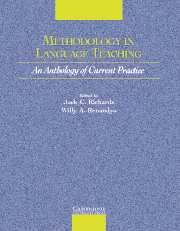Book contents
- Frontmatter
- Contents
- Acknowledgments
- Introduction
- Section I Approaches to Teaching
- Section 2 Lesson Planning and Classroom Management
- Section 3 Classroom Dynamics
- Section 4 Syllabus Design and Instructional Materials
- Chapter 7 The ELT Curriculum: A Flexible Model for a Changing World
- Chapter 8 The Role of Materials in the Language Classroom: Finding the Balance
- Section 5 Task and Project Work
- Section 6 Learning Strategies
- Section 7 Teaching Grammar
- Section 8 Teaching Pronunciation
- Section 9 Teaching Speaking
- Section 10 Teaching Listening
- Section 11 Teaching Vocabulary
- Section 12 Teaching Reading
- Section 13 Teaching Writing
- Section 14 Assessment
- Section 15 Technologies in the Classroom
- Section 16 Professional Development
- Credits
- Author Index
- Subject Index
- References
Chapter 7 - The ELT Curriculum: A Flexible Model for a Changing World
Published online by Cambridge University Press: 10 November 2010
- Frontmatter
- Contents
- Acknowledgments
- Introduction
- Section I Approaches to Teaching
- Section 2 Lesson Planning and Classroom Management
- Section 3 Classroom Dynamics
- Section 4 Syllabus Design and Instructional Materials
- Chapter 7 The ELT Curriculum: A Flexible Model for a Changing World
- Chapter 8 The Role of Materials in the Language Classroom: Finding the Balance
- Section 5 Task and Project Work
- Section 6 Learning Strategies
- Section 7 Teaching Grammar
- Section 8 Teaching Pronunciation
- Section 9 Teaching Speaking
- Section 10 Teaching Listening
- Section 11 Teaching Vocabulary
- Section 12 Teaching Reading
- Section 13 Teaching Writing
- Section 14 Assessment
- Section 15 Technologies in the Classroom
- Section 16 Professional Development
- Credits
- Author Index
- Subject Index
- References
Summary
INTRODUCTION
It is clear that it is no longer enough to teach merely the structures and rules of a language – the myriad approaches to curriculum design which have sprung up in the last four decades under the umbrella of ‘the communicative approach’ have illustrated the shortcomings and lack of relevance of the grammar-systems model of language teaching. Language is communication, and as teachers we must develop in our learners the ability to communicate effectively in a wide range of professional and social contexts. But is it possible to teach a language within the four walls of a classroom? I think not – and so we also need to help our learners to learn how to learn and to keep on learning. I would like to quote the famous educator Carl Rogers, who makes a strong plea for learner- and learning-centred learning as the only possible model for education in a world that is changing faster than ever before:
We are, in my view, faced with an entirely new situation in education where the goal of education, if we are to survive, is the facilitation of change and learning. The only man who is educated is the man who has learned how to learn; the man who has learned how to adapt and change; the man who has realized that no knowledge is secure, that only the process of seeking knowledge gives a basis for security. […]
Information
- Type
- Chapter
- Information
- Methodology in Language TeachingAn Anthology of Current Practice, pp. 69 - 79Publisher: Cambridge University PressPrint publication year: 2002
References
Accessibility standard: Unknown
Why this information is here
This section outlines the accessibility features of this content - including support for screen readers, full keyboard navigation and high-contrast display options. This may not be relevant for you.Accessibility Information
- 17
- Cited by
